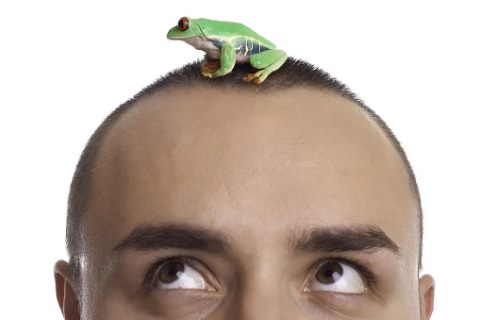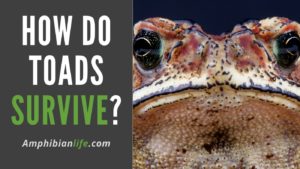
Wondering Why Is My Frog Swimming Upside Down? Do frogs lay or hang upside down? Frogs are fascinating creatures known for their unique behaviors and adaptations. One puzzling behavior that often raises concern among amphibian enthusiasts is when a frog is found lying upside down. This article delves into the various reasons behind this peculiar phenomenon, exploring both natural and environmental factors that may contribute to a frog assuming such a position.
Understanding the Upside-Down Phenomenon in Frogs
Reason 1: They Lost Their Balance:
One common reason for frogs lying upside down is a loss of balance. Frogs are agile creatures, but sudden movements, awkward landings, or slippery surfaces can cause them to lose their equilibrium. This imbalance can result in the frog temporarily adopting an upside-down position until it regains its stability.
Reason 2: Stress:
Environmental stressors play a significant role in a frog’s behavior. Sudden changes in temperature, light, or noise levels can induce stress, leading to disorientation. In response to stress, a frog might exhibit unusual behaviors, including lying upside down. Addressing and minimizing stressors in the frog’s environment is crucial to maintaining its well-being.
Reason 3: Defense:
Certain frog species employ unique defense mechanisms, and assuming an upside-down posture can be one of them. This behavior might be an attempt to confuse predators or deter them from pursuing the frog further. Understanding the natural defense strategies of specific frog species is essential for interpreting such behaviors accurately.
Reason 4: Toxins and Chemicals:
Frogs are highly sensitive to environmental toxins and chemicals. Exposure to pollutants in their habitat, such as pesticides or contaminants in water sources, can negatively affect their nervous system. In response, a frog may display abnormal postures, including lying upside down, as a manifestation of the toxic impact on its physiology.
Reason 5: Sickness:
Illness or infection is a significant factor contributing to abnormal frog behavior. When frogs are sick, their motor functions may be impaired, leading to peculiar postures. An upside-down position can be a visible sign of an underlying health issue, prompting the need for veterinary attention to diagnose and treat the ailment.
Reason 6: Seizures:
Seizures in frogs can manifest in various ways, including erratic movements and abnormal postures. A frog experiencing a seizure may temporarily lie upside down due to the uncontrolled muscle contractions associated with the seizure activity. Identifying and addressing the underlying causes of seizures is crucial for the well-being of the affected frog.
Reason 7: Starvation:
Insufficient food intake or malnutrition can lead to weakness and muscle problems in frogs. A malnourished frog may struggle with normal movement, potentially resulting in an upside-down position. Providing a balanced and appropriate diet is essential for preventing starvation-related issues in captive frogs.
Reason 8: Abnormal Water Temperature and pH:
Frogs are ectothermic, meaning their body temperature is influenced by the external environment. Drastic changes in water temperature, especially in aquatic species, can impact a frog’s physiology and behavior. In extreme cases, a frog may adopt an upside-down position as a response to temperature stress. Monitoring and maintaining appropriate water conditions are crucial for the well-being of aquatic frogs.
Reason 9: Ammonia or Nitrate in Tank Water:
Poor water quality poses a significant threat to amphibians, especially those living in aquatic environments. High levels of ammonia or nitrate in tank water can lead to stress and health problems, causing frogs to behave abnormally, including assuming an upside-down posture. Regular water testing and proper filtration are essential for preventing water quality-related issues.
Reason 10: Buoyancy Issues:
Some frogs may experience buoyancy issues, making it challenging for them to maintain the correct orientation in water. This can result from factors such as gas retention or irregular swim bladder function. Buoyancy problems may cause a frog to float or drift, leading to an upside-down position.
Reason 11: Swim Bladder Disorder:
The swim bladder is a crucial organ for buoyancy control in aquatic frogs. Disorders affecting the swim bladder can disrupt a frog’s ability to maintain its proper position in the water. As a consequence, the frog may exhibit an upside-down posture. Identifying and addressing swim bladder issues require careful observation and, if necessary, veterinary intervention.
Reason 12: Spinal Injury:
Accidents, falls, or collisions can cause injuries to a frog’s spine, affecting its ability to orient itself correctly. Spinal injuries may result in abnormal postures, including lying upside down. Careful handling and providing a safe environment are essential for preventing such injuries.
Reason 13: Parasites:
Internal parasites can compromise a frog’s overall health and behavior. Certain parasites can affect the nervous system, leading to abnormal postures. Regular veterinary check-ups and preventive measures are crucial for managing and treating parasitic infections in captive frogs.
Reason 14: Death:
Tragically, an upside-down position in a frog may be a sign of its demise. Death can be attributed to various factors discussed earlier, such as illness, stress, or environmental toxins. Recognizing signs of distress and addressing potential issues promptly can help prevent fatal outcomes.
Related FAQ’S
Q1: How can I recognize signs of distress in my frog?
A1: Signs of distress in frogs may include changes in behavior, loss of appetite, lethargy, abnormal postures, or vocalizations. Regularly observe your frog and seek veterinary attention if you notice any unusual signs. Early detection and intervention can improve the chances of successful treatment.
Q2: Can a frog recover from being upside down?
A2: The ability of a frog to recover depends on the underlying cause of the upside-down position. In many cases, addressing the root issue, such as providing appropriate veterinary care, improving environmental conditions, or adjusting diet, can help the frog regain normal behavior. However, swift action is crucial for a successful recovery.
Q3: How can I improve water quality for my frog?
A3: Maintaining proper water quality is crucial for amphibians. Regularly test the water for parameters like ammonia and nitrate levels. Ensure proper filtration and water circulation in the tank. Perform regular water changes to prevent the accumulation of harmful substances. Creating a clean and suitable aquatic environment is essential for the health of your frog.
Q4: What should I do if my frog is showing signs of sickness?
A4: If your frog is displaying signs of illness, such as lying upside down, it’s important to seek veterinary attention promptly. A vet specializing in amphibian care can diagnose the underlying issue and recommend appropriate treatment. Pay attention to other symptoms, such as changes in skin color, lethargy, or abnormal behavior, and provide this information to the vet.
Q5: Can nutritional deficiencies cause a frog to lie upside down?
A5: Yes, nutritional deficiencies can lead to weakness and muscle problems in frogs, causing them to struggle with normal movement. Ensuring your frog receives a balanced and appropriate diet is essential for preventing issues related to malnutrition.
Q6: How can I prevent accidents and injuries in my frog’s habitat?
A6: To prevent accidents and injuries, provide a well-designed and secure habitat for your frog. Avoid sharp or rough surfaces, and ensure that climbing structures are stable. Handle your frog with care, and be cautious during feeding to minimize the risk of collisions. Regularly inspect the habitat for any potential hazards.
Q7: What can I do if my aquatic frog is experiencing buoyancy issues?
A7: If your aquatic frog is having buoyancy issues, it may be related to factors like gas retention or swim bladder disorders. Consult with a vet to determine the cause and appropriate treatment. Adjusting water temperature, providing a balanced diet, and creating a suitable aquatic environment can also help alleviate buoyancy problems.
Q8: Are there any preventive measures for parasitic infections in frogs?
A8: Regular veterinary check-ups, proper hygiene, and quarantine procedures for new frogs can help prevent parasitic infections. Avoid introducing wild-caught frogs into your collection without thorough examination. Provide a clean and well-maintained environment to reduce the risk of parasitic infestations.
Conclusion:
Understanding the reasons behind a frog lying upside down is crucial for ensuring the well-being of these captivating amphibians. From natural behaviors and defense mechanisms to environmental stressors and health issues, a variety of factors can contribute to this phenomenon.
By actively monitoring and addressing potential stressors, providing a suitable environment, and seeking veterinary care when needed, amphibian enthusiasts can contribute to the overall health and happiness of their frog companions.

Hi, I’m Mike, and I’m the creator of amphibianlife.com. If there was one word to describe it? It would be: passionate about Amphibians! Whether you want to know more about amphibians or have a presentation to give at school, you’ve come to the right place.







